A galvanizing conversation starter since its Cannes premiere, Blue Is the Warmest Color has rather persistently been positioned as a "lesbian" film, particularly in the popular press. To be sure, its controversial elements stem from its unblinking representation of same-sex erotic contact, of two young women who, in terms that they never explicitly discuss, perform oral sex (among other acts) on one another. I loved the film, found myself swept up in its torrential romanticism, in its uncanny capturing of the idiosyncratic awkwardness of youth, and especially in the lead performance of relative newcomer Adèle Exarchopoulos, whose character's emotions are perilously close to the surface and keep spilling over. That said, I share some specifically queer reservations about the film, its content, and especially its labeling.
The film's central character, Adèle, does not identify as a lesbian. At first, her refusal to do so (following a somewhat hokey masturbation scene that is intercut with fantasy images of her female love object) seems reflective of her self-denial, her internalized homophobia, and her somewhat cowardly response to schoolyard pressure. As the film progresses, however, it becomes increasingly clear that Adèle has no intention of ever identifying as queer, and for me, the film appeared to fall into a fashionable "post-gay" rhythm, recalling the Brokeback Mountain conception of same-sex love as an inchoate "force of nature," and finally preempting any connections to queer history. (Compare, for instance, Xavier Dolan's equally epic Lawrence Anyways, with its sobering and edifying awareness of many of the historical methods by which the legal and medical fields have sought to legitimize transphobia.) I am wont, for a variety of reasons, to defend Blue Is the Warmest Color, but under no circumstances will I call it a "lesbian" film.
My response may say more about me than about Blue, for I consider myself exclusively gay in spite of having been steeped in queer theory for most of my adult life, and I resent the rapidly intensifying suggestion that this information is unimportant, even pathologically superfluous in a "post-gay" society. What certainly isn't superfluous, what is politically as well as taxonomically significant, even in the 21st century, is the "queer" label in the arts, the kind of designation that can serve a community-building and community-sustaining function, that announces and endorses LGBTQIA authorship, and that delineates (but cannot guarantee) a safe space for consumption by sexual minorities.
In general, there are two ways of gauging a film's queerness, two approaches to taxonomy. One is to assay the director's public persona for signs of a clear queer consciousness, of a non-straight sexual-orientation identity. The other is to apply similar reading strategies to the film's protagonist, the person through whose eyes the narrative unfolds, for whom the experiences explored seem to matter the most. The two approaches -- let's call them the Authorship Model and the Main Character Model, respectively -- rarely generate a "lesbian" label. Perhaps owing to a rather deep-seated stereotype of straight masculinity wherein "lesbian" sex is performed purely for the delectation of men, global cinema history is filled with titles that often erroneously go by the name "queer." These include, conspicuously, films directed by straight-identified men that offer extended "lesbian" sex scenes but whose central characters are inescapably estranged from queer identity politics, who don't, simply put, self-define as gay.
Consider, for instance, a pair of equally controversial American films: Personal Best, from 1982, and The Killing of Sister George, from 1968. In the former, written and directed by straight-identified auteur Robert Towne, Chris (played by the strapping Mariel Hemingway) enters into a sexual relationship with another woman, a fellow pentathlete (played by Patrice Donnelly), without ever considering herself a lesbian. In fact, the "point" of the film appears, in part, to be to "prove" that same-sex erotic activity is but a stepping stone toward a more "mature," procreative form of sexuality, as Chris "evolves" into an appreciation for boys, eventually pairing up with a male swimmer and self-identifying as straight. (In Blue Is the Warmest Color, Adèle appears to trace a reverse trajectory, breaking up with a boy in order to pursue her passion for a girl, but she later responds with keen-eyed interest to a handsome young man who twice tells her that she's desirable, a guy's dream.) In Sister George, directed by straight filmmaker Robert Aldrich (known mostly for his "manly" action films), a self-identified lesbian, uncouth at home and increasingly unsuccessful at work, watches her much-younger girlfriend fall for an elegant female television executive, who, in a notorious extended sex scene, propels her toward orgasm with her pale, manicured hands.
Neither film fits the twofold taxonomic model outlined above, even if Sister George seems closest with its loud-and-proud lesbian protagonist. How, then, might one make sense of Blue Is the Warmest Color, whose lengthy, wordless sex scenes recall the similarly nonverbal, equally protracted depiction of vaginal play in Sister George? Is Blue a "straight" film or a "gay" one? The film's director, Abdellatif Kechiche, is firmly straight-identified, like Towne and Aldrich. His film has spurred debates about voyeuristic depictions of intertwining female bodies, as surely as did Personal Best and Sister George (neither of whose sex scenes seems quite as suggestive of gay-for-pay pornography as Blue's first "lesbian" encounter, with its rhythmic panting and static shots). Kechiche's feature is not, strictly speaking, a "lesbian" film, according to either the Authorship Model or the Main Character Model. Does that matter? I think so, particularly since the film has generated such bad press, with widely circulating stories of on-set sadism that smack of over a century of movies made by men well-schooled in the cruel manipulation of women. In cinema, behind-the-scenes psychology still matters, especially to the extent that it helps us measure a film's queer credentials.